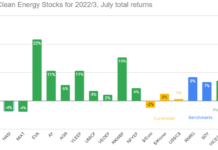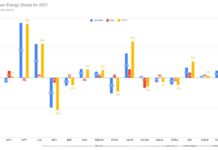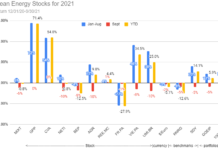Update: an expanded version of this portfolio appears here. Alternative Energy: Risky but Alluring
For many of my older or more cautious clients, investment in small, profitless (or nearly so) startup alternative energy companies is inappropriate. Even a diversified ETF such as the Powershares Wilderhill Clean Energy portfolio (AMEX: PBW) is too volatile due to its heavy exposure to profitless renewable energy companies such as Evergreen Solar (ESLR) (NasdaqGM: ESLR). Because of this, in the last year PBW has been over $24, but as low as $16.24. While such volatility can lead to supercharged profits when you are riding it in the right direction, many investors cannot sleep at night if one of their holdings lose a third of their value in just a couple months (as PBW did last year.)
Nevertheless, growing awareness of Global Warming, Peak Oil, Gas, and Uranium, and energy security worries are leading to broad interest in alternative energy among people who do not fit the typical aggressive speculator profile of people who can shrug off a 50% loss in a single holding over a short period of time.
The Blue-Chip Solution
Fortunately, not all companies involved in alternative energy are risky startups. For an investor who is willing to own stocks which are not pure-play companies, getting an exposure to quality businesses in alternative energy can actually be easier than finding quality companies among the firms whose business is purely devoted to a singe renewable energy technology. In fact, many of the industry leaders are actually divisions of larger conglomerates. For instance, the largest US Wind Turbine manufacturer is GE Wind (NYSE: GE), while Sharp Solar (Pink Sheets: SHCAY) is the world’s leading manufacturer of solar modules. Conglomerates are by far the easiest way to invest in Energy Efficiency, the dullest but most profitable alternative to conventional energy generation.
While these companies lack the sex appeal of overnight high flyers like First Solar (NasdaqGM: FSLR), which has doubled since its IPO less than six months ago, they also provide a lot more downside protection than bombs like Distributed Energy Systems (NasdaqGM: DESC) which down about 60% over the same period, and off over 80% from its all time high. Any investment adviser or financial planner will tell you that diversification is key to a healthy portfolio: these companies have built-in diversification from their wide array of businesses. Below, I highlight some of my favorites.
Using your Ecomagination
I’ve already mentioned GE’s leadership in wind turbines, but their Ecomagination division (with it’s attendant publicity) also includes a healthy does of energy efficient technologies, including not only the familiar compact fluorescent lamps, but also LEDs, more efficient gas turbines, consumer products, and on and on. Their Jenbacher engines are widely used to generate electricity from a wide variety of biogas, and a the also have a solar photovoltaic division (which used to be the independent PV company AstroPower, which they bought out of bankruptcy.) GE does play the whole Ecomangination thing up, while they are still selling pulverized coal plants as well (they were the planned supplier for TXU… and they’ll probably still sell three of those.) On the other hand, GE’s CEO Jeffrey Immelt has said "Renewable energy, energy efficiency, environmental technology – we’re going to own it." I believe he’s serious about that, and GE will try to "own" all those things. They have a better chance of owning renewable energy than First Solar, and if they are going to "own" renewable energy, wouldn’t a renewable energy investor want to own GE?
An efficient choice
Another favorite of mine is Johnson Controls (NYSE: JCI.) Johnson’s Building Efficiency segment "engages in the design, production, and installation of control systems that monitor, automate, and integrate building operating equipment and conditions." In short, they are deeply involved in the next generation of more efficient buildings. Since energy efficiency is the most cost effective form of alternative energy, this business is much less susceptible to the wild roller-coaster ride of other alternative energy stocks which gyrate wildly in response to fears (or hopes) of skyrocketing energy prices. They also have a joint venture with Saft to produce batteries for the hybrid vehicle market, which GM recently awarded a battery development contract.
Some call it "Trash," I call it "fuel."
You might be surprised at my next pick: Waste Management (NYSE: WMI). What does trash have to do with renewable energy? As a feedstock. Not only does WMI have recycling operations, but they operate at least 86 landfill gas projects which produce electricity, but also have 17 waste-to-energy operations. While in the short term, rising fuel prices will cut into their operating margins, capturing methane (a highly potent greenhouse gas) should be a valuable source of carbon credits (once there is a market for these), and recycling is an excellent way to save energy compared producing raw materials. Another future potential revenue source from alternative energy will be waste to energy. While WMI already operates 18 waste to energy facilities, there is a lot of room for new developments such as plasma conversion, which can make the process cheaper and more efficient.
Climate Action Partnership
You might also look for blue chip companies by looking at their actions. Companies which feel they are strategically positioned for serious political action to prevent climate change will probably also be lobbying for such action. In January, seven major companies formed the Climate Action Partnership with three national environmental nonprofits. They are calling for real cuts to carbon emissions, and you can bet that part of the reason is they feel it will benefit their shareholders (if they called for action on climate change, but felt that it would hurt their shareholders, those same shareholders could legally sue them for any damage to the bottom line.) The fact that the cuts they are calling for are fairly aggressive is significant, because many industry lobby groups have called for carbon regulation, but only because they (rightly) fear that if they’re not at the table when the negotiations take place, they’ll end up being served as the main course.
Here’s a quick rundown of the companies in the partnership, and why I think they are each participating:
- Alcoa: lightweight recycled aluminum for more efficient vehicles.
- Caterpillar: Much waste methane electricity generation is based on CAT engines and turbines. They also stand to benefit from the rush to biofuels because they are a major supplier of farm equipment. [UPDATE: it turns out that this is not actually true. They sold their farm tractor segment in 2002, and it was never a large part of their operations.]
- Duke Energy: While not a major generator of renewable energy, they are hoping carbon regulation will benefit their nuclear heavy strategy (they’re also doing some good things in cogeneration aka combined heat an power.)
- DuPont has been reducing their carbon footprint for two decades, and they also have considerable biofuels operations.
- FPL Group: Currently the world’s largest operator of wind energy. Less talked about, they also own more concentrating solar power stations than any other utility.
- GE: see above.
- PG&E: Great energy efficiency programs, wind, solar.
- PNM Resources: Before this, I had never associated PNM with environmental responsibility (or irresponsibility for that matter.) Greenwashing? Their territory has a lot of potential for concentrating solar power and wind… I hope that’s what they’re thinking. I’d love to hear your opinions.
That’s not the entire list. Others that come to mind are ADM (biofuels), Deere (farm equipment), Siemens (Wind, PV, transmission), and Owens Corning (wind turbine blades). The point is that there’s no problem filling a diversified portfolio with large, stable companies that can also benefit from rising energy prices and regulation of carbon emissions. Your alternative energy portfolio is less limited by lack of choice or aversion to risk than it is by unwillingness to accept some bad with the good.
I like to look not for companies that are perfect, but more for ones that are headed in the right direction. A profitable portfolio is built on tomorrow’s winners, not yesterday’s. The same can be said for an environmentally responsible portfolio.
DISCLOSURE: Tom Konrad and/or his clients have positions in the following stocks mentioned here: ESLR, GE, Sharp, JCI, WMI, Dupont, FPL, ADM, Deere, Siemens.
DISCLAIMER: The information and trades provided here are for informational purposes only and are not a solicitation to buy or sell any of these securities. Investing involves substantial risk and you should evaluate your own risk levels before you make any investment. Past results are not an indication of future performance. Please take the time to read the full disclaimer here.








I agree emphatically with pretty much everything you say Tom.
Such a shame the US autos in Detroit didn’t keep their eyes on the ball…
It would have saved alot of pain…
I do note with great interest all the majors you mention whom seem to be “grasping the bull by the horns” and ain’t waiting around, by introducing ambitious R&D portfolios based on sustainablity principles.
In the mature economies we now live in – innovation is the companies lifes-blood. Managers and investors have to watch policy, R&D, finance and a mulititude of other socilological indicators.
We truly do live in the knowledge-based economy now…
– where sustainability is going to be King and Alt-Energy will be “the power behind the throne”…
(couldn’t resist it)
Tom:
“DuPont has been reducing their carbon footprint for two decades, and they also have considerable biofuels operations.”
You also should consider that the “biorefinery” suits all their other areas of business – including providing the feedstocks for many of the other products existing and new they wish to produce.
Therefore, this is of parallel interest to them. Double the possibilities for the same investment.
On DuPont, I agree. There is a lot more that can be said about all the companies I mention in the article, and how alt-e will affect their businesses. And there are many other companies I could have mentioned that I didn’t… This morning I’m kicking myself for not mentioning Phillips (PHG) who said last week that incandescents should be phased out by 2016… they seem to feel they’re well established in CFLs and LEDs.
I have been looking for the same kind of ideas, and I keep coming back to a stock that I know pretty well up here in Canada. Canadian Hydro Developers, who is a diversified pure green power producer in Canada. The have 17 different producing power projects diversified by fuel source. Hydro, Wind and Biomass. They have been in business since 1983 and have a strong growth track record and portfolio of future development projects.
It is worth a look for those interested in non-US names.
Scott
http://www.canhydro.com/www2005/index.htm
Canada is an exteremely rich hunting ground for Renewable Energy based utilities. Boralex and the Canadian Income Trusts I profiled on March 4 are also worth a look. Be careful , however, not to concentrate too much in one sector (even a relatively stable one like utilities) or one country (Canada, or even the US) if you’re trying to build a truly diversified portfolio.
Anyone aware of an ETF that encompasses many of these companies?
There is no such ETF… The closest things to ETFs in this space are KLD (socially responsible companies in the S&P 500) and two Powershares ETF’s PBW and PUW which focus on pureplay RE companies. I’ve written a couple articles on these ETFs here:
http://tomkonrad.wordpress.com/2006/12/28/social-etfs-and-clean-energy-etfs/
http://tomkonrad.wordpress.com/2006/11/26/etfs/
but there is no one following this strategy that I know of. I suggest buying the stocks individually (but don’t let any of these stocks account for more than 3% of your portfolio in order to maintain diversification. Keep in mind that your mutual fund/ETF holdings will probably include exposure to these stocks already, and that should be considered part of the 3%.)
Note that this strategy only makes sense if you have enough money that your brokerage comissions are less than 1% of the amount invested, and you plan to hold the position (not trade in and out.)
Thanks for the article Tom, this is a good snapshot of where industry is making positive advancements on their energy use and energy-related product development.
The rising tide of Climate Change has us wondering; is there enough rafts for every corporation? Quite literally we are seeing a change in global ecosystems. Debate on the causes of climate change is waning to a new debate on how best to mitigate its effects on society. Leading the charge to a new era of responsible energy use is some of the largest energy users in the world. Firms like GE, PNM, Suncor Energy, Toyota, Boeing, Green Mountain Coffee, FPL, Staples, Wal-Mart and Siemens have energy front and center on their agenda. Their goal: develop cleaner and more efficient products; reduce greenhouse gas emissions; mitigate energy price fluctuations by developing or purchasing renewable energy; and search for new energy solutions that are sustainable and stand the test of time.
The rising role of energy on corporate strategy, government policy and intervention and social equity and justice is driving new paths of growth in a carbon constrained world. Large institutional investors like Bank of America and Goldman Sachs are investing in and financing energy efficiency, renewable generation and growth in the “social response product development” sector. Firms like INNOVEST, Calvert, Standard and Poor’s, Portfolio 21 and IRRC are quantifying, measuring and reporting the “intangible” values firms report as they integrate sustainable strategies into their core business practices. These social investment leaders are helping to make the “intangible” values of business more tangible – resulting in a social investment industry that exceeds $2 trillion under management.
For the energy sector all of this is good news. Corporations are reinventing themselves as they operate in this new era of social response capitalism.
I’d like to alert you and your readers to a wonderful book that will be released April 3rd that captures the heart and essence of how these trends impact the energy industry.
Titled “World Inc.: When It Comes to Solutions — Both Local and Global — Businesses Are Now More Powerful Than Government��? the book was written by environmental business expert Bruce Piasecki. The book is available at http://www.worldincbook.com.
A review by Corporate Responsibility Officer Magazine notes, ““World Inc. is a manifesto for the corporate responsibility revolution. The book’s heroes are “social response capitalists,��? examples of which include leaders at GE, Toyota, HP, S&P, Whirlpool, Tom’s of Maine, Innovest and Suncor.��?.
And a recent review by Publishers Weekly stated, “In his optimistic account, Piasecki, an environmental consultant, identifies a new consumer expectation: that corporations have social obligations…. Piasecki provides some insight into a successful corporation’s shift toward social response capitalism through innovation and leadership…. Each of its three sections is fodder enough for a book.”
World Inc. examines how fifty-one of the world’s top 100 economies are now corporations, and more than 40% of world trade now takes place within multinationals. In the book Piasecki presents social response leaders as he confronts the issue: “As power moves into the hands of corporations, the world is looking to business instead of government to solve its problems��?. His response: “The corporations that can best address social issues by creating superior products will thrive and profit in this new world.��?
With insight from firms like HP, Suncor Energy, Whirlpool, Tom’s of Maine, Green Mountain Coffee Roasters, Toyota, Innovest and others, Piasecki’s World Inc. is the social and business guidebook to how leading businesses are growing revenue while going green.
To learn more on World Inc. see http://www.worldincbook.com. To learn more about executive workshops on green growth contact Mark@ahcgroup.com and see http://www.ahcgroup.com
Of the companies you list, I have some real doubts about Suncor, because they are so concentrated in oil sands. While oil sands are a great beneficiary of peak oil, they produce extremely carbon intensive oil, so global warming legislation may be a problem for them. (I believe Suncor is part of a coalition to explore enhanced geothermal for process heat in their oil extraction, but any results from that are a decade away. http://tomkonrad.wordpress.com/2007/02/10/the-irony-of-enhanced-geothermal/